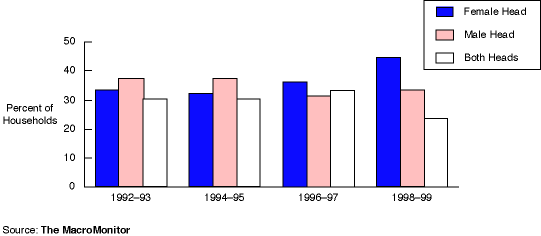Women as Financial Consumers: Gaining Ground MacroMonitor Marketing Report Vol. IV, No. 2 January 1999
Increasing numbers of women are participating in financial decision making for their households. The newest MacroMonitor reveals that more women are increasingly confident in their financial decision-making ability. Although women, as financial consumers, are making steady advances, industry perceptions about women may not be keeping pace. Today's women are not a single market segment that is uninformed, risk averse, and savings-product oriented. Recent MacroMonitor data show the gains in financial sophistication that women have made. As a whole, women are diversifying more in the products they select and choosing instruments such as stocks and mutual funds that carry higher risk exposure.
Who Handles Finances

The 1998-99 MacroMonitor data show a substantial increase in the proportion of households in which the female head is the major financial decision maker. Unlike questionnaires in previous years, the 1998-99 questionnaire first asked who is the financial decision maker handling most of seven specific areas of financial services. Then it asked who handles most of the household's major financial decisions overall—the same question that appeared in previous years. The addition of this more detailed question preceding the general question likely made the respondent more aware of who actually is handling the household finances, resulting in fewer respondents' picking "both male and female heads of household" and more respondents' picking "female head of household." Thus, although the change in questionnaire design warrants caution in interpreting trend data, the new figure probably presents a more realistic picture of household financial decisionmakers—that is, more women actually handle the household's finances than previous surveys had indicated.
Single women and women householders with annual incomes of $50 000 or more account for 4 percent of total U.S. households—a modest but potentially attractive market segment for the financial industry. Married-couple households in which financial decisions are shared and that have annual incomes of $50 000 or more represent another 23 percent. Approximately, then, 27 percent of U.S. households include affluent women with more than basic financial product and service needs.
What kinds of women make up this target market? Why, and how are these women different? Using SRIC-BI's (now SBI's) VALS™ consumer psychographic segmentation system, this MacroMonitor report provides insights into the types of women consumers who represent potential for financial service companies. It focuses on two upper-resource VALS segments: Resource-rich women, who are sophisticated and have discretionary income to invest and Income-earning women, who are less sophisticated but are working to move up the financial learning curve. Recognizing their financial attitudes and advice preferences, financial institutions can market their products and services more successfully to these women.
Whether sharing or solely responsible for financial decisions, women are integrally active in directing the financial stability and security of almost 70 percent of all U.S. households. With women gaining confidence and sophistication, financial institutions will increasingly deal with growing numbers of better informed but time-constrained women consumers. For those institutions interested in capitalizing on women as financial decision makers, now is the time to challenge traditional assumptions and change financial products and delivery systems to meet the needs of the women's market.

The 1998-99 MacroMonitor data show a substantial increase in the proportion of households in which the female head is the major financial decision maker. Unlike questionnaires in previous years, the 1998-99 questionnaire first asked who is the financial decision maker handling most of seven specific areas of financial services. Then it asked who handles most of the household's major financial decisions overall—the same question that appeared in previous years. The addition of this more detailed question preceding the general question likely made the respondent more aware of who actually is handling the household finances, resulting in fewer respondents' picking "both male and female heads of household" and more respondents' picking "female head of household." Thus, although the change in questionnaire design warrants caution in interpreting trend data, the new figure probably presents a more realistic picture of household financial decisionmakers—that is, more women actually handle the household's finances than previous surveys had indicated.
Single women and women householders with annual incomes of $50 000 or more account for 4 percent of total U.S. households—a modest but potentially attractive market segment for the financial industry. Married-couple households in which financial decisions are shared and that have annual incomes of $50 000 or more represent another 23 percent. Approximately, then, 27 percent of U.S. households include affluent women with more than basic financial product and service needs.
What kinds of women make up this target market? Why, and how are these women different? Using SRIC-BI's (now SBI's) VALS™ consumer psychographic segmentation system, this MacroMonitor report provides insights into the types of women consumers who represent potential for financial service companies. It focuses on two upper-resource VALS segments: Resource-rich women, who are sophisticated and have discretionary income to invest and Income-earning women, who are less sophisticated but are working to move up the financial learning curve. Recognizing their financial attitudes and advice preferences, financial institutions can market their products and services more successfully to these women.
Whether sharing or solely responsible for financial decisions, women are integrally active in directing the financial stability and security of almost 70 percent of all U.S. households. With women gaining confidence and sophistication, financial institutions will increasingly deal with growing numbers of better informed but time-constrained women consumers. For those institutions interested in capitalizing on women as financial decision makers, now is the time to challenge traditional assumptions and change financial products and delivery systems to meet the needs of the women's market.